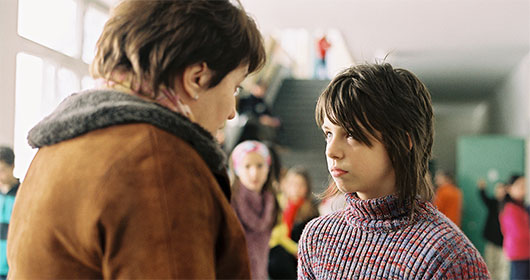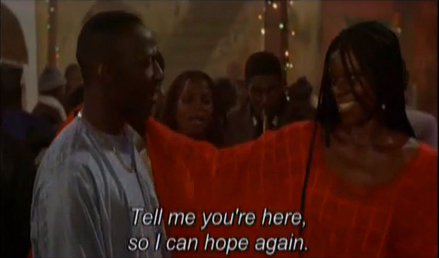
A couple of years ago I decided to take a permanent break from attending movie theaters. The reason was that movies are boring, predictable, repetitive and just not worth it. I declared that movie going is a stage that I have proudly passed, or, as my sister says: “it’s something you do to get out of your system and move on.” In fact the last movie that I have attended was in 2012 in a theater located in Kuwait. After viewing last week’s film, Timbuktu, my faith in the film industry might just be restored.
As I was watching the film, I wondered why it was deprived from the same level of Hollywoodian celebration and advertisement. I have never seen, heard, read, or watched anything about it. After reading Manthia Daiwara’s On Tracking World Cinema: African Cinema at Film Festivals, it turns out that” the lack of public for African Cinema in Africa is a complex issue” (385). The article laments the losing focus on African films in favor of other means of attracting tourists, French in particular, and emptying their pockets.
”[I]t is not just a film festival anymore, it is a Grunde FEte highlighting drummers from Burundi, fashion shows, and business entrepreneurship in the streets of Ouagadougou. It is a festival of the sponsors: the festival cares more about pleasing the French tourists than about African filmmakers. For 5,000 Francs CFA (about twenty dollars), anybody can buy a badge stating that he or she is an invited guest, just like filmmakers. The programming is too political, not to say chaotic, favoring some filmmakers, and excluding others.(387) Furthermore, the article implies that Colonialism is still present in a different form, the county is corrupt and its African citizens are unappreciated and mistreated, for instance: “some filmmakers have to sleep in hotel lobbies. And some hotel managers are corrupt: FESPACO paid full price for rooms, but some of its guests were told that the hotel had no rooms available, so that the same accommodations could be rented to tourists. There are never enough seats in the movie theaters for certain films” (387).
Adberrahmane Sissako’s article Timbuktu and its Controversial Reception points out that “[i]n addition to the captivating cinematography and original soundtrack, the film offers a valuable African point of view on a timely conflict in much the same way Newton Aduaka did with Ezra (2007).” I completely agree with this statement. In addition to that, this film is the perfect embodiment of Jacques Lacon’s mirror stage. I say this because the film presents various close ups on the characters’ faces which establishes an emotional and intimate connection between them and the viewers. Close ups on Toya’s face, leads the viewer to establish a close relationship with her. She is admired for her positivty, innocence, kind heart, but mostly her love and respect for her parents. She brings the father water and helps her mother to wash her hair. The viewers’ emotional connection with Toya increase with every close up on her face and smiles. Close ups also help the film covey the nature of Toya’s relationship with her father. The scene where Toya is taking to the young shepherd is a good example of this relationship because the camera closes up on her little innocent face as she exults her father’s virtues and praises him for his skill with a musical instrument. This scene is juxtaposed with another were her father’s death sentence is announced and he is about to meet his fate.
Toya’s father, Kidane, is another close up star. In the scene were his is questioned and his sentence announced the camera closes up on his face as tears run down his checks and hold that close up shot long enough for us to establish eye contact with him. According to the Lacanian mirror stage, we recognize him a mirror in which we see ourselves and connect with Kidana’s tragedy. The brilliance of close ups lays in the character’s refrain from gazing at the camera, but at the same time the close up lasts long enough for the us to establish eye contact thus connecting with the character and reconnecting with ourselves. The lack of close ups can also demonstrate their power, Kidana enjoys the privilege of close ups while those who Islamic extremists endeavor, who endeavor to sharia law, are deprived from it. Therefore, no emotional connect or sympathize is created in their favor.
Q- Manthia Daiwara On Tracking World Cinema: African Cinema at Film Festivals argues that “most of the filmmakers in the last category confront social problems such as sex education, poverty, polygamy, and corruption in post-independence Africa. They draw on elements of popular culture like song and dance, oratory, traditional theater, and popular stars. Their films are about the African public sphere, where entertainment is linked to hidden messages about how to be smart in the city, honesty as a virtue, and the failure of African systems to improve the lives of the citizens” (394-395). Where do you see that in Kala, Karmen Gie, and Timbuktu?
Q- Manthia Daiwara On Tracking World Cinema: African Cinema at Film Festivals explains that “ FESPACOs credibility is threatened by two important factors. First,
it is no longer a secret that the films from North Africa receive only secondary
prizes, reserving the big ones such as Etulon de Yenengu, and the Oumarou Granda
Award to French co-produced sub-Saharan African films. Tunisian cinema is
experiencing its golden age, with directors such as Nouri Bouzid and Ferid
Boughedir, but they have been silenced at the last two FESPACO along with
brilliant directors from Morocco and Egypt. Is it possible that Tunisian cinema’s
explorations of a new film language that dares to include homosexuality and
eroticism have dissuaded FESPACO from celebrating it? (389).”
Is this a revelation to anybody?
Isn’t the aim of a film is to present a realistic image of the world and the timey issues they struggle with? Why is homosexuality still a determining factor of whether FESPACO celebrates a film or overlook it?
Q- Adberrahmane Sissako’s Timbuktu and its Controversial Reception describes a scene where “Islamist recruits announce the implementation of Sharia law using megaphones, going street by street, and speaking in local languages. Women—even fishmongers—must wear veils, socks, and gloves, while men are told to roll up their pants legs in the style of the Taliban (271).” How does this scene help you understand the hidden message of the film?










